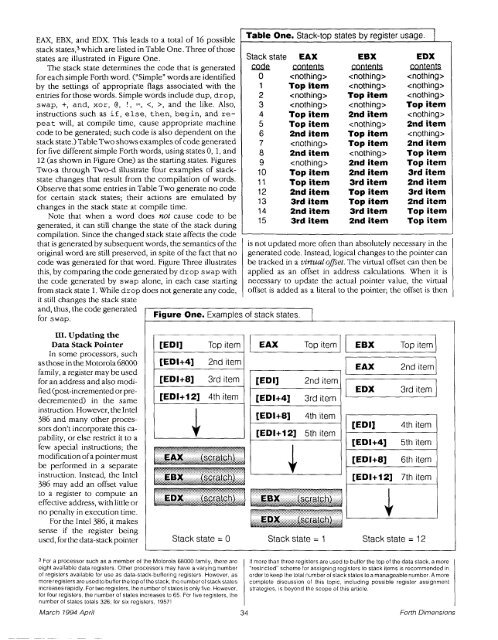FAST Forth Native-Language Embedded Computers
FAST Forth Native-Language Embedded Computers
FAST Forth Native-Language Embedded Computers
You also want an ePaper? Increase the reach of your titles
YUMPU automatically turns print PDFs into web optimized ePapers that Google loves.
EAX, EBX, and EDX. This leads to a total of 16 possible<br />
stack states,:, which are listed in Table One. Three of those<br />
states are illustrated in Figure One.<br />
The stack state determines the code that is generated<br />
for each simple <strong>Forth</strong> word. ("Simple" words are identified<br />
by the settings of appropriate flags associated with the<br />
entries for those words. Simple words include dup, drop,<br />
swap, +, and, xor, @, !, =, , and the like. Also,<br />
instructions such as if, else, then, begin, and repeat<br />
will, at compile time, cause appropriate machine<br />
code to be generated; such code is also dependent on the<br />
stack state.) Table Two shows examples of code generated<br />
for five different simple <strong>Forth</strong> words, using states 0, 1, and<br />
12 (as shown in Figure One) as the starting states. Figures<br />
Two-a through Two-d illustrate four examples of stackstate<br />
changes that result from the compilation of words.<br />
Observe that some entries in Table Two generate no code<br />
for certain stack states; their actions are emulated by<br />
changes in the stack state at compile time.<br />
Note that when a word does not cause code to be<br />
generated, it can still change the state of the stack during<br />
compilation. Since the changed stack state affects the code<br />
that is generated by subsequent words, the semantics of the<br />
original word are still preserved, in spite of the fact that no<br />
code was generated for that word. Figure Three illustrates<br />
this, by comparing the code generated by drop swap with<br />
the code generated by swap alone, in each case starting<br />
from stack state 1. While drop does not generate any code,<br />
it still changes the stack state<br />
and, thus, the code generated<br />
for swap.<br />
Figure One. Examples of stack states. 1<br />
m. Updating the<br />
Data Stack Pointer<br />
In some processors, such<br />
as those in the Motorola 68000<br />
family, a register may be used<br />
for an address and also modi-<br />
fied (post-incremented or pre-<br />
decremented) in the same<br />
instruction. However, the Intel<br />
386 and many other proces-<br />
sors don't incorporate this ca-<br />
pability, or else restrict it to a<br />
few special instructions; the<br />
modification of a pointer must<br />
be performed in a separate<br />
instruction. Instead, the Intel<br />
386 may add an offset value<br />
to a register to compute an<br />
effective address, with little or<br />
no penalty in execution time.<br />
For the Intel 386, it makes<br />
sense if the register being<br />
used, for the data-stack pointer<br />
For a processor such as a member of the Motorola 68000 family, there are<br />
eight available data registers. Other processors may have a varying number<br />
of regislers available for use as data-stack-buffering registers. However, as<br />
more registers areused to buffer the top of the stack, the nurnberof stackstates<br />
increases rapidly. For two registers, the number of stales is only five. However,<br />
for four registers, the number of states increases to 65. For five registers, the<br />
number of states totals 326; for six regislers, 1957!<br />
Table One. Stack-top states by register usage I<br />
Stack state EAX EBX EDX<br />
m!& contents contents
















